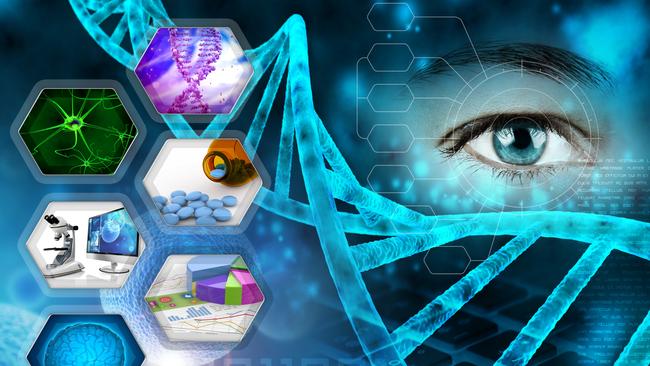The can-do tech millionaires now believe they can defy death
From pills to injections, tech millionaires are trying to biohack into immortality.

They have made billions by the age of 30, their apps and ads are global phenomena and they believe we’ll see computer-augmented brains and 4000km/h trains by 2030. In Silicon Valley you have to think big and believe anything’s possible. Mark Zuckerberg, the 33-year-old Facebook co-founder, has donated $US3 billion ($3.8bn) to “cure all diseases” by the end of the century. Others go farther, arguing that ageing is reversible and youthful immortality is within reach.
Larry Ellison, the 73-year-old co-founder of Oracle, told his biographer, “Death has never made any sense to me,” viewing the Grim Reaper as another corporate rival to be outfoxed. And so Ellison and his peers are investing in start-ups that promise to use technology and data to make 100 the new 40. And ordinary Valley workers, who already pop pills to work through the night and network at kitesurfing events, are joining their superiors in “biohacking” their bodies.
Reinvigorate your organs, with litres of teen plasma
The creepy middle-aged tech boss who receives reinvigorating shots of teenage blood is a dystopian storyline in the HBO series Silicon Valley, but one based on real life. Peter Thiel, the 49-year-old billionaire tech investor who believes solving the “problem” of death is “the most natural thing”, has expressed interest, although he hasn’t “quite, quite, quite started (on transfusions) yet”.
Ambrosia, a start-up in San Francisco and Tampa, offers “young blood” infusions at $US8000 a two-litre fix. The company, which has moved from one Bay Area office to two city-centre clinics in a year, has about 100 clients. Anyone over 35 is eligible. A transfusion of plasma from a 16 to 25-year-old, sourced from blood banks, takes about two hours.
“Our first clients were biotech chief executives,” says Jesse Karmazin, the 32-year-old Stanford managing director who founded Ambrosia. “Now it’s broader. More men, mostly in their 60s, though it ranges from 30s to 90s. About 10-15 per cent are really into ‘biohacking’ and will be doing other treatments, diets, etc.”
Karmazin was inspired by parabiosis studies that involve sewing together the blood vessels of two mice. In the experiments, the organs of the older mouse, including its heart, brain and muscles were reinvigorated, and even its coat became shinier.
Ambrosia’s research, based on 70 customers, found improvements in biomarkers related to cancer, heart disease and Alzheimer’s after one treatment. Karmazin says one patient’s hair colour reverted from grey to black and most customers gain considerable pep. Other researchers point out that parabiosis studies on mice are far removed from blood transfusions in humans. They say the self-reported findings of Ambrosia patients could largely be down to the placebo effect.
Take a $US25,000 gene test
Craig Venter, the 70-year-old scientist who sequenced the second human genome, is a co-founder of Human Longevity, a San Diego company that is geared to extending lifespan by providing a barrage of genetic and other tests. The start-up secured $US300 million from investors including GE Ventures, the venture capital subsidiary of General Electric.
For $US25,000, with one eight-hour test, the company’s health nucleus division will sequence your genome, analyse your microbiome — your gut bacteria — run MRI and CAT scans, cognitive tests and more. It will also analyse your family history and create a computer-generated avatar of you as an interface for exploring the terabytes of information.
Venter believes that, without drilling down to data, other longevity strategies can too easily come to nothing. “Many of our clients do rigorous exercise, or they have restricted diets. You can exercise or diet all you like, but still have a tumour.” He claims the exam finds “something seriously wrong” in 40 per cent of “healthy” participants. According to a non-peer-reviewed study, this screening detected “age-related chronic diseases requiring prompt (fewer than 30 days) medical attention” in 8 per cent of the 209 subjects, and MRIs found early-stage cancer in 2 per cent.
That includes Venter. His MRI scan revealed a “high-grade” prostate tumour, although previous PSA tests had been clear. “There are prostate cancers that you die from, or you die with. This one you’d die from but we got it in time and I’m now cancer-free. The very next thing the team did was look at my genes to identify any markers that put me at higher risk; we found them. The more data we can collect, the more of these associations we can make.”
Critics say the tests collect overwhelming quantities of data and will probably deliver false positives. “If I wanted to write a Swiftian parody illustrating the insanity of this extreme version of (precision medicine), I could not have written a better paper,” Nigel Paneth, a pediatrician and epidemiologist at Michigan State University, told Science in response to Venter’s findings. He said the tests could lead to psychological harm, unneeded further tests and big bills.
Still, genetic healthcare is clearly a growth industry. More than 500 people, aged between 18 and 92, have had the Human Longevity “precision medicine” experience, while millions of Americans have opted for a cheaper option — the $US199 genetic health and ancestry tests from Mountain View-based 23andMe, run by 44-year-old Anne Wojcicki, the former wife of Google co-founder Sergey Brin.
The Silicon Valley mogul, who discovered he had a mutation of a gene associated with Parkinson’s disease, is fascinated by the science behind it: Brin’s own company has invested more than $1bn in a subsidiary focused on “health, wellbeing and longevity” called Calico — the California Life Company.
Pop the prescription pill with life-giving properties
Ray Kurzweil takes more than 100 pills a day, including statins and nutritional supplements, and puts his biological age “in the late 40s”. The 69-year-old futurist, who leads Google’s AI team, is an adviser at Calico and has moonlighted on one of Google chief executive Larry Page’s pet projects: “solving death”.
Although he disregards drugs that are “unproven” or “appear to be risky”, including the human growth hormone and “microdoses” of LSD that many tech workers guzzle like candy, one treatment he swears by is metformin, a diabetes drug that’s patent-expired and costs about 5c a tablet. It’s based on Galega officinalis, or goat’s rue, a plant that has been taken as medicine for diabetes since medieval times.
Since its introduction for diabetes treatment in the 90s, studies comparing patients on metformin with those on other drugs suggested that the former tended to be significantly healthier, and in unexpected ways. They lived longer, had fewer cardiac troubles and were less likely to get Alzheimer’s, dementia or cancer.
The eureka moment came with studies indicating that metformin patients didn’t only outlive diabetics on other treatments but also control groups who didn’t have diabetes. Yet the drug’s mechanisms remain poorly understood and its alleged anti-ageing properties aren’t proven.
Cheat a bit with subtle Botox and baggy pants
In Silicon Valley, people don’t only go under the knife because they want to look hotter. Surgeons say tech workers increasingly feel they have to have work to stand a chance of staying relevant — it’s about staying “young” to survive.
Usha Rajagopal, the medical director of the San Francisco Plastic Surgery Centre, says she is seeing more people in their late 30s and more men than before. “In the tech world it’s people in their 20s and early 30s at the top of the pile. Even when they’re 38, people really feel they’re ageing. We might give them some subtle Botox and fillers. They’d pay maybe $US900-$1200 a year.”
This pressure is a product of the ageism in the US technology industry, where median employee ages of about 30 are the norm in companies such as Facebook and Google, compared with 42 across all industries. As a result, Rajagopal says middle-aged men don’t only have their faces pricked and tucked but increasingly tend to dress like 20-year-olds, hanging up their chinos and button-downs in favour of baggy pants and T-shirts. Hair is a particular preoccupation. Tesla founder Elon Musk has appeared, without authorisation, as a poster boy for hair transplant companies after the balding crown of his late 20s was superseded by the full head he has at 46. The consensus is that he has had first-rate surgical work rather than some mysterious wonder drug.
Do the ‘Atkins on steroids’ diet (but hold your breath)
Diet is the obsession of the California biohacker. Studies of high-fat, low-carb diets suggest they can promote weight loss and improve markers of heart disease. The ketogenic, or keto, diet may also increase mitochondria in brain cells, potentially warding off age-related brain diseases.
On an ordinary carb-based diet, the body breaks down carbs for glucose, which is used for energy or stored as glycogen in liver and muscle tissue. Without carbs, the body breaks into its fat stores for energy, using a process called ketosis.
The keto diet, dubbed “Atkins on steroids”, bans refined carbohydrates and encourages a nutrient intake split roughly 70:25:5 between “good” fats, protein and unrefined carbs. This can lead to rapid weight loss but evangelists for the regimen say it’s as much about mental and youthfulness gains.
Silicon Valley bosses commonly combine the keto diet with periodic fasting for up to 36 hours before filling up on bacon, eggs and avocado. There are obvious downsides, however. The transition to keto often brings low energy levels, brain fog and bad breath in the short term. Many people report constipation.
The diet is recommended for some children with epilepsy, under strict supervision, but doctors stress it’s otherwise unproven and could have long-term negative effects. Molly Maloof, a Silicon Valley doctor who charges from $US5000 for a first assessment to $US40,000 for one year’s comprehensive care, told Quartz people in Silicon Valley accept treatments that are totally unproven. “This is a place where people don’t give a flying f..k what they do with their minds and bodies,” she said.
If all else fails, freeze your head
Even advocates for extraordinary lifespans in the next century and “immortality” shortly thereafter, concede that they might not live to see the day. That’s why Thiel, Kurzweil and their ilk have booked themselves space in cryogenic facilities. The idea is that, once they die, the $US200,000 upfront fee and yearly subscription will pay for their bodies to be kept on ice until science figures out a way to revive them.
To the can-do tech mindset, this is logical, although mainstream science continues to dismiss the practice — which dates to the 1960s and involves replacing one’s blood with antifreeze shortly after death and storage at minus 196C — as pseudoscience.
Max More, the British futurist who runs Alcor, an Arizona cryonics facility popular with tech chief executives, has said he plans to go for the lower cost ($US50,000) option of having his severed head preserved. In a documentary he said: “It’s impossible to give a date for when we can revive people. It could be decades, a century. We are like Leonardo da Vinci, who could design wings and a helicopter which could work — but he didn’t have the tools to build them back then.”
The Times



To join the conversation, please log in. Don't have an account? Register
Join the conversation, you are commenting as Logout